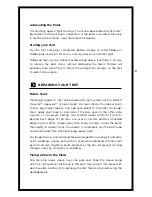
sET-up
A note about shock-corded poles
Shockcord (bungee cord) is meant to keep pole sections in the proper
order—not as an automatic assembly mechanism for poles. Do not hold
one section while whipping the rest of the pole back and forth, or toss
the poles into the air; either procedure excessively stresses the pole joints
and shockcord. Instead, fit poles together section by section, making sure
that each piece slides completely into the next. Forcing an improperly
assembled pole into place can damage the pole and/or the tent body
and fly.
Assembling the Tent
1
Assemble all poles carefully as described in the previous paragraph.
You will have one six-poled system fitted into a centre hub, plus two
equal-length poles and one shorter pole.
2
Lay the tent body out flat.
In windy conditions, you may wish to peg one or more corners.
3
Lay the hubbed tent poles down on the tent body with the hub
roughly in the middle, and the crooked gold poles pointing toward the
gold webbing tabs on the tent body.
This will ensure the pole system is
oriented correctly to the tent body.
4
Plug the pole ends into the grommets in the webbing tabs at each
corner of the tent.
It’s easiest to plug in the poles in pairs. Attach one pole, followed by the
pole directly opposite it. The poles arch up more easily this way, and have
less of a tendency to pull out of the grommets. You may find it easiest to
do the two black poles along the tent’s longest axis first (that is, from the
outermost corner to the other outermost corner). Then do one gold pole
followed by one of the remaining black poles.
5
Clip the pole clips to the poles that you inserted into the grommets.
The clips have colour-coded ribbons that match their proper poles. The
third highest gold-ribboned pole clips on each side of the front door should
be clipped into the inside of the plastic elbow on the corresponding gold
pole. Each wing of the tent has one gold ribbon that has two clips; leave
these unattached for now.
Summary of Contents for Frontenac
Page 10: ......



























